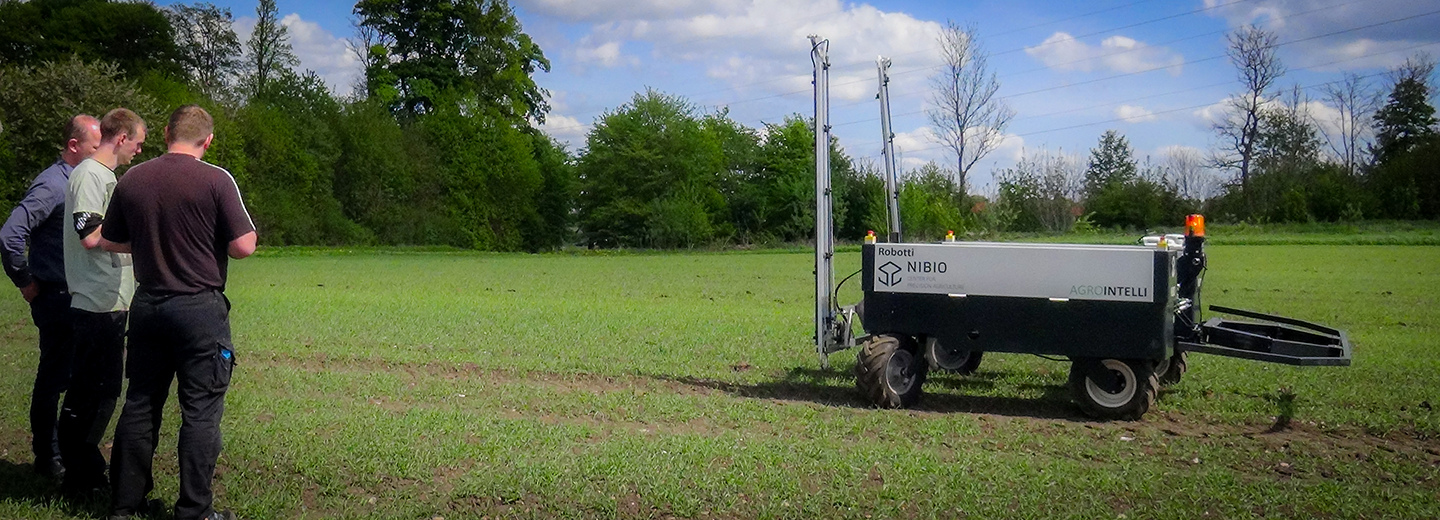
Meadows mowed by a robot
The first robot tractor has been sold, and the company behind it expects to sell twenty more by 2018. In collaboration with the company AgroIntelli, researchers have developed a system that makes it safe enough for robots to be let loose in the fields.
The first self-driving field robot has been sold. Its name is Robotti, and it is the robot equivalent of a tractor that can pull everything from harrows to seeders. The completely cabin-less Robotti is now driving around the fields of Norway. The company ArgroIntelli expects to turn out 20 more Robottis by 2018.
- There are around twenty companies in Europe who are proud of developing self-driving agricultural robots. But when it comes to safety, we are in the lead. With this research project, we've managed to develop safety systems that make self-driving robots safe to use in the fields.
This is according to Ole Green, Chief Executive Officer of the company AgroIntelli which specialises in self-driving agricultural machines. The company has participated in the research project SAFE with the aim of making agricultural machines so safe that they can with all good conscience be released in fields.
Just like Google's self-driving cars
One of the researchers who has developed Robotti's safety system is Associate Professor Kjeld Jensen from SDU Drone Centre. Along with the other partners in the project, he has carried out numerous simulations and real tests in the struggle to to get the different stereo cameras, laser scanners and pressure sensors to work with the robot's artificial intelligence so that the robot can see all obstacles in a field and take sensible precautions to avoid them.
- By removing the driver from the tractor, we need to be able to guarantee maximum safety for humans and animals. We've done this by giving the robot two layers in its behaviour. It is proactive, so it can act in time when its sensors and cameras register obstacles in the field, says Kjeld Jensen:
- The robot also has a reactive behaviour, so it has an emergency stop function if it doesn't register the obstacle - a kind of extra safety precaution that makes it stop. Exactly like Google's cars, we use a lot of detection technology that works with the robot's behaviour, so we can ensure that all obstacles are registered and the robot reacts by stopping, going round them or raising the work tools.
Robot collects golf balls
The research project SAFE started in 2013 with a total budget of 29 million kroner, of which the Innovation Fund Denmark granted 15 million. And the research has resulted in several successful spin-outs. For instance, golf enthusiasts will be pleased to learn that the project has resulted in a robot that can gather up golf balls without driving into golfers' legs.
As a participant in the research project SAFE, the company Conpleks has made use of the researchers' knowledge to upgrade the safety of the company's newest branch on the robot tree, namely a self-driving robot for the collection of golf balls. With the safety system in place, the golf ball-collector drives around the golf course, scanning its surroundings.
Drones and field robots become colleagues
As mentioned, the first Robotti has been sold to a customer in Norway. The customer is the Norwegian Institute of Bioeconomy Research, NIBIO, which researches in sustainable agriculture. Ole Green has already arranged demonstrations of Robotti for the autumn and is hoping to convince farmers that it is good business to hand over the monotonous work of driving back and forth in fields to a robot.
- It's an intelligent tool. It's extremely precise as well as being able to handle large amounts of data. We have conducted many tests in the fields around Skejby in Aarhus. It drives around, does the boring work and asks for help if it isn't sure about something. The only problem we haven't solved yet is when animals are hiding in the grass, says Ole Green.
In order to solve that problem, Associate Professor Kjeld Jensen points out that the farmer's machine park in the future will consist of both field robots and drones, which will work together on tasks in the best possible way. When drones and field robots work together, it increases effectiveness and safety in the fields, he explains:
- Field robots are limited by only being able to register what is close to them, but drones have the advantage that they have a large overview. My colleagues at Aarhus University have shown, for example, that a drone can successfully fly over a field with a heat sensitive camera so that all animals are registered before the field robot is released in the field. Drones can also increase effectivity in the fields because the drone can pass on a message about where it is safe for the machines to drive more quickly.
Partners in research project SAFE
AgroIntelli APS (Project Leader)
Aarhus University
CLAAS E-Systems
Conpleks Innovation ApS
Innovation network RoboCluster
KeyResearch ApS
University of Southern Denmark